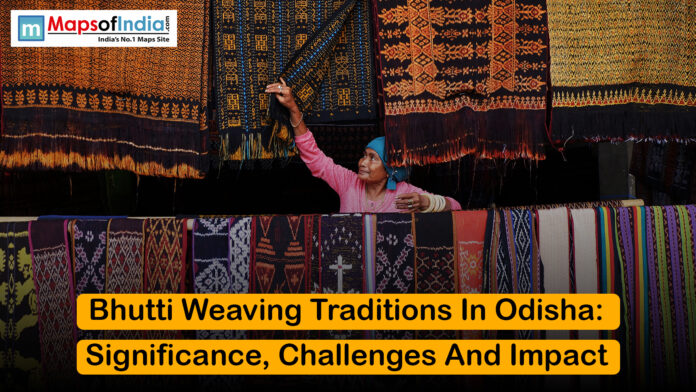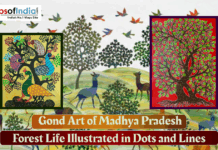In eastern India, Odisha prides itself on being one of the states with the richest history in India’s long fabric-making tradition. One of the finest artists in Odisha, Bhutti weaving continues to flourish. This technique is characterised by finely intricate designs forming within the cloth and not later added on through stitching.
The Historical Significance of Bhutti Weaving
The weaving technique of Bhutti has existed in Odisha since the 12th century. It is said to have been supported by the Eastern Ganga dynasty. Bhutti is derived from the Odia language as it concerns the microcosm ‘Bhutti’, meaning designed ‘small figures’, or it might also simply mean ‘designs’.
Bhutti weavers used to make clothes for ritual participants and temple deities for Jagannath Temple, located at Puri. The fabrics were also utilised for religious processes. The geometric shapes, alongside stylised flora and fauna, were intense and meaningful. Thus, each piece signified devotionally considerable rather than only ornamental.
These textiles represented Odishan identity for centuries and contained symbols for other communities and families within the state. They are designed to be an heirloom that stands the test of time.
The Decline: Challenges Faced by Traditional Weavers
Bhutti weaving instantly disappeared until the last quarter of the 20th century, when artificial textiles emerged. The highly costly handmade fabric faced tough competition with the flow of very cheap machinery that churned out synthetic stuff. The slow transition in fashion direction towards the Western style also heavily contributed to the lack of traditional handloom products demand.
Because of economic influences, the manual occupations skilled weavers once devoted their lives to have become incompatible with financial demands. This loss of artisans created a knowledge gap, as the youth viewed the trade as laborious and unattractive.
The Initiatives that Sparked The Revival
Several heritage-inspired cultural advocates and artisans have been mobilising on the issue of Bhutti weaving. These activists were the first to introduce themselves on the scene. Various aspects of the subject made them come forward, thus contributing much to revitalising the craft.
Government Aid
They are economically significant and culturally important; hence, the government immediately revived these crafts after noticing their impact. Several measures are introduced to enhance these artisans. Among those is the dramatic ‘Bhutti Resurgence Programme‘ undertaken in 2018, which trained weavers, constructed country infrastructure, and directly marketed artisans’ products.
Through this program, the government initiated subsidised raw material centres, thereby supplementing promotional activities for artisanal artisans, directly altering their income, and establishing designated training institutions that led to the concentration of exceptionally skilled artisans. Their training is beyond conventional patterns, but it assists students with modern design elements in fashion. However, this subsidised equipment in education permits lower production costs. Thus, lower prices can be maintained and still be profitable with cheap but quality goods.
Collaborated Design Innovations
To revive Bhutti textiles, traditional weavers and new-age designers collaborate. The Weavers’ Service Centre at Bharati Bhawan seeks to warm the association of NIFT and NID by blending the old with the new.
Such collaborations have given rise to modern products that retain the traditional essence of Bhutti techniques, mainly catering to urban clients. Products like sarees, home furnishings, accessories, and new apparel helped harness additional market opportunities due to colour preferences and motif design experiments.
Digital Marketing and Global Reach
Thanks to this Bhutti age, the distance between the consumer and the product does not matter at the cosmopolitan weaves. There have been sites dedicated to handicraft e-commerce, such as the ones named GoCoop and Okhai, which finally make it possible for a community of weavers to have access to national and international markets without pinning the years of intermediaries mechanics who exploit poor practices and allow handcrafters to win from fair profits.
The stories orbiting the textiles were sold to conscious consumers needing sustainability and authentic-to-the-soul, ethical production via a goal-oriented social media campaign. This kind of narrative marketing has changed Bhutti weaving from an obsolescent craft to a top-drawer, in-demand luxury coveted at exorbitant prices at home and abroad.
Sustainable Fashion Movement
Sustainability in the fashion world has opened up many opportunities for Bhuttis weaving. Hand-woven textile articles are easy substitutes for fast fashion since consumers are becoming sceptical about sustainability and its social impacts on their purchases.
Bhutti textiles are produced using natural fibre. They are very slow and require manual labour but do not leave a huge environmental mark. However, textiles are also sustainable fashion because of their long-lasting durability and timeless appeal.
Impact on Weaver Communities
The revival of Bhutti weaving has transformed artisan communities across Odisha. Recent studies have shown that weavers have increased by 00% since 2018. More than five thousand are weaving, and many youths, many pursuing other studies or careers, will return to this traditional profession later.
Skilled Bhutti weavers are also economically sustainable now, with monthly earnings of ₹15,000-25,000, on par with entry-level white-collar jobs in cities. This trackback is called reversing rural to urban migration; otherwise, it may lose the community lifestyles and knowledge systems associated with the disruption of much urbanising.
Establishing weaver cooperatives has given artisans further autonomy, allowing them to share resources and knowledge and organise for collective bargaining. Many cooperatives have introduced member welfare schemes, such as health insurance, support for children’s education, and retirement pensions—social security systems previously absent for these delegates in the informal sector.
Problems and the Next Steps
Besides these achievements, specific problems threaten the continued revival of Bhutti weaving. Raw material prices are always on the rise, and competition is very much there from machine-made replicas, which generally degrade the authenticity of hand-woven articles. There is also no proper intellectual property protection, with instances of design theft reported by various weaver communities.
Climate change constitutes a severe further constraint, characterised by its erratic weather patterns, which wreak havoc upon cotton and traditional dyeing processes. Hence, adaptive research into climate installation and exploring sustainable alternatives become critical if this revived art is to survive.
Technology consistently delivers such breakthroughs, and they do not cease to come. One recent application of blockchain technology is authentication. Another is augmented reality, which can enable virtual participative assembly right at the last minute. Other advances in perception could enhance one’s artistry in creating the product itself.
Conclusion
Unlike most international buyers who are becoming more sensitive to the authenticity of their purchases from every Bhutti Textiles cradle, Bhutti cradles every story about craftsmanship from forefathers, eco-friendliness, and community empowerment. This craft renaissance tells us about the prospect of reconciling ancient traditions and innovations that can bridge the chasm between the past and future.
For the Bhutti weavers of Odisha, each shuttle that passes through the warp threads creates stunning fabric and interlaces cultural identity, economic growth, and eco-friendly advancements, a design worth safeguarding for future generations.




